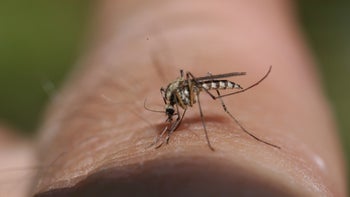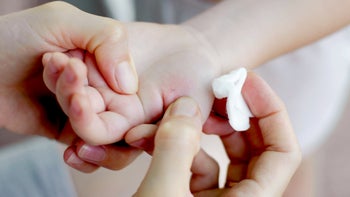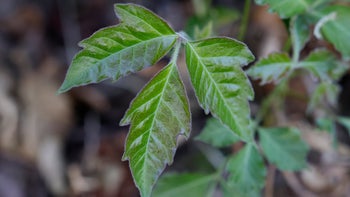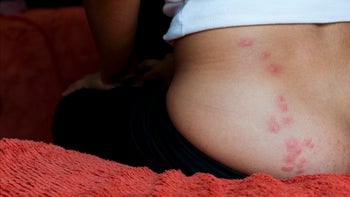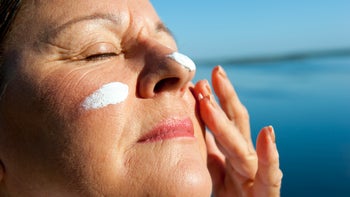
The 6 Best OTC Treatments and Home Remedies for Poison Ivy, Oak, and Sumac
Key takeaways:
A poison ivy rash can happen when you’re exposed to the oil in a poison ivy plant (urushiol). The same rash can happen from contact with poison oak or sumac.
There are over-the-counter (OTC) poison ivy treatments that can help relieve some of the most bothersome symptoms — like itchiness, burning, and redness.
While most people can treat a poison ivy rash at home, more severe cases may need medical attention and prescription medication.
Table of contents
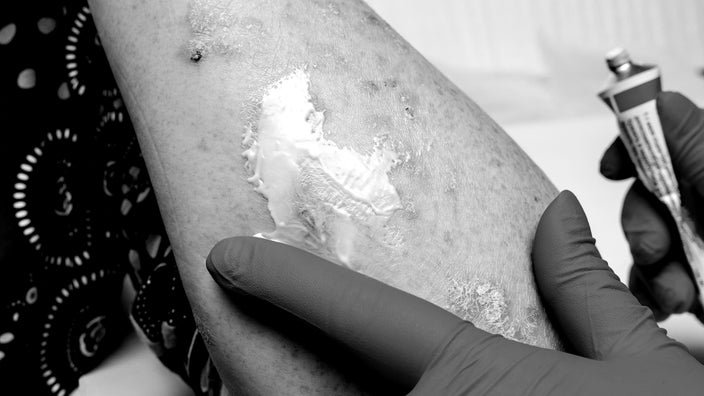
More than half of the population in the U.S. is allergic to the oil on the poison ivy plant. This oil — known as urushiol — is in every part of the plant, including the leaves and stem. Urushiol is also found in poison oak and sumac plants.
When the oil touches your skin, it can cause redness, swelling, itchiness, and a blistering rash (tiny bubbles of skin filled with fluid). These symptoms can be quite uncomfortable and cause you to seek fast relief to soothe your rash.
How do you treat a poison oak, ivy, or sumac rash?
As soon as you realize you’ve been exposed to poison ivy, oak, or sumac, you should:
Wash your skin with soap and cold water. Wash any surface of the skin that may have been exposed to the poison ivy. You can also use rubbing alcohol to clean the skin.
Wash exposed clothing. This helps remove urushiol and may help prevent further spread.
If a rash occurs, don’t scratch the area or pop any blisters that form.
Stay healthy with CVS
Shop the brands you trust at CVS. Whether it’s wellness or beauty, get what you need at great prices.

OTC treatments and home remedies for poison ivy rash
Let’s review six over-the-counter (OTC) products and home remedies that might be helpful.
1. Oral antihistamines
Antihistamines are a group of medications that treat many allergic conditions. These medications work by blocking histamine — a natural chemical your body makes when you have an allergic reaction.
Antihistamines are particularly helpful for itch relief. There are two groups of antihistamines:
First-generation antihistamines: These medications, like diphenhydramine (Benadryl), often cause drowsiness. If your poison ivy rash is itchy and keeps you up at night, a first-generation antihistamine may help.
Second- and third-generation antihistamines: These groups of medications are less likely to make you drowsy. Examples include cetirizine (Zyrtec), loratadine (Claritin), and fexofenadine (Allegra). These antihistamines may be better to treat itchiness during the day.
Since antihistamines have side effects, they’re not the best OTC treatment for everyone. And they shouldn’t be given to children under 6 years old.
2. Steroid creams
Hydrocortisone 1% cream is a low-dose topical steroid. It can help your poison ivy rash by lowering the inflammation that causes redness and itchiness. Apply it to your rash 3 to 4 times daily for no more than 2 weeks. Here are some brand-name OTC steroid creams you may find at your pharmacy:
Cortizone-10
Aquaphor Itch Relief Ointment
CeraVe Hydrocortisone Anti-Itch Cream
Exederm Flare Control
Think you might have a poison ivy rash? Take a look at these images of what a poison ivy rash looks like and what you should do about it.
Does calamine lotion work? Yes. Find out when to use calamine lotion and how to use it correctly.
Do clothes protect you from poison ivy? Learn more about how to keep from spreading poison ivy through your clothing.
3. Oatmeal baths
Oatmeal baths can be a helpful remedy for any sort of irritated skin, including poison ivy rashes. They help reduce inflammation and moisturize your skin. This can also help prevent dry skin, which can worsen poison ivy rash irritation.
Oatmeal baths are easy to prepare at home using uncooked oatmeal. To prepare an oatmeal bath:
Use any unflavored oatmeal.
Grind or blend the oatmeal in a food processor.
Add the oatmeal powder to a bathtub with lukewarm water.
Soak in the tub for 15 minutes.
Read more like this
Explore these related articles, suggested for readers like you.
4. Calamine lotion
Calamine lotion is a mix of zinc oxide and ferric oxide, which can help soothe and dry up oozing blisters. This can also help any itching from poison ivy and sumac.
Calamine products sometimes contain pramoxine (a local anesthetic), too. Pramoxine works by numbing your skin, which may relieve itching and pain associated with your rash. Each calamine product may be a little different, so follow the directions on the label for how to apply it.
5. Astringents
Astringents can help relieve your rash by drying out the blisters that are oozing fluid. Useful OTC astringents include witch hazel, calamine lotion, and aluminum acetate (Domeboro).
Domeboro solution comes in packets that you mix with water. Mix 1 to 3 packets in 16 oz of water and stir until it dissolves:
If you’re using the solution as a soak, submerge the affected area in the mixture for 15-30 minutes.
To use the mixture as a wet compress, soak a clean cloth in the solution and cover the affected area for 15-30 minutes.
You can repeat this process 3 times daily or as recommended by a healthcare professional.
6. Cool compresses
Cooling down your skin can be a simple yet effective home remedy — especially when you have the urge to scratch. To do this, wet a clean washcloth with cold water and apply it directly to your skin. Try not to rub your skin with the cloth, as that can worsen skin irritation.
What’s the best OTC medication for a poison ivy rash?
When it comes to OTC medications and home remedies, no single treatment is better than the other. The best treatment for you will depend on your symptoms and your personal preferences.
For example:
For itching: An oral antihistamine may be most helpful. Benadryl is better at night since it makes you sleepy. Nondrowsy antihistamines — like Zyrtec — are better during the day.
Topical treatments: If you prefer not to take an oral medication, steroid creams and calamine lotion can also help relieve itching.
For blistering: Calamine lotion and astringents are good options to treat oozing blisters.
Home remedies: Oatmeal baths and cool compresses are nonmedication options that can help soothe your skin and relieve itching.
Your medical history matters, too. Talk with a healthcare professional first if you’re pregnant, take other medications, or have health conditions. This is especially important with oral medications. A healthcare professional can help you choose a treatment that’s safe for you.
Side effects from OTC poison ivy rash treatments
Like all medications, side effects may occur after using OTC poison ivy treatments. Below, we cover potential side effects that different poison ivy medications can cause.
OTC medication | Common side effects |
|---|---|
Tiredness, dizziness, constipation, difficulty urinating, dry mouth | |
Steroid (hydrocortisone 0.1%) cream | Burning, itching, dry skin |
Oatmeal bath | Dry skin |
Dry skin | |
Astringents (Domeboro) | Dry skin |
When should you get medical care for a poison ivy rash?
Get immediate medical attention if you’re experiencing any signs of a severe reaction. These include:
Difficulty breathing
Chest tightness
Wheezing or coughing
Swelling around your eyes, face, lips, or mouth
In some cases, you may need prescription medication — like oral steroids — to help treat your rash. You may also need additional testing or an evaluation to make sure the rash isn’t caused by something else.
See a healthcare professional as soon as possible if:
Your rash isn't getting better after 7-10 days.
You’re not sure the rash is from poison ivy, oak, or sumac.
Your rash covers 25% or more of your body.
The rash has spread to your face or genitals.
You have itching that makes it impossible to sleep or work.
You should also see a healthcare professional if you notice any signs that your rash could be getting infected. These include:
A fever
Pus or soft, yellow scabs
Tenderness or pain to the touch
Frequently asked questions
Poison ivy and poison oak can be spread from person to person as long as the oils from the plants remain on your skin or clothing. Once the oils from the plants are washed off, they can no longer be spread.
After you come in contact with a poison ivy plant, a rash can appear as soon as 4 hours later. But this can vary. It can also take up to 2 to 3 days for a rash to appear. How quickly your body develops a rash will depend on how much plant oil you got on your body and how sensitive you are to the oil.
Scratching your rash usually makes it even more itchy. This is because scratching naturally causes your body to release more histamines, which make your skin feel itchy. Scratching can also cause breaks in your skin, leaving it open to infections like cellulitis. As much as possible, it’s best to avoid scratching your rash.
The bottom line
Many people are allergic to the oil in poison ivy, oak, and sumac. Fortunately, many OTC treatments can alleviate your symptoms. These can be an effective way to relieve itchiness and soothe your skin. Keep in mind that these OTC treatments are best for mild rashes. If your rash or symptoms feel moderate to severe, see a healthcare professional as soon as possible. You may need additional treatment to help keep you safe and speed up your recovery.
Why trust our experts?


References
Advantice Health. (2024). Domeboro- aluminum sulfate tetradecahydrate, calcium acetate monohydrate powder, for solution [package insert]. DailyMed.
Afassco. (2023). Afassco 1% hydrocortisone ointment [package insert]. DailyMed.
American Academy of Dermatology Association. (n.d.). Poison ivy, oak, and sumac: How to treat the rash.
Gladman, A. C. (2006). Toxicodendron dermatitis: Poison ivy, oak, and sumac. Wilderness & Environmental Medicine.
Joy, N. (2022). Calamine lotion. Journal of Skin and Sexually Transmitted Diseases.
U.S. Food and Drug Administration. (2021). Outsmarting poison ivy and other poisonous plants.






